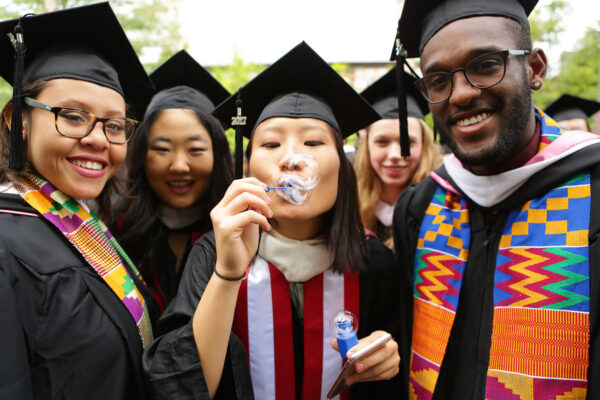By Robin Matross Helms
In June, I participated in a seminar sponsored by World Education Services (WES) and the Boston College Center for International Higher Education (my graduate alma mater) called “International Education in a New Political Climate” where I was asked to give an update on U.S. higher education internationalization since the 2016 presidential election—key events, their impact on the climate for internationalization and the prognosis for the future.
To prepare for my talk, I drew on data from ACE’s newly released report, Mapping Internationalization on U.S. Campuses, as well as on the insights and experiences of institutions in the midst of an intensive strategic planning process for internationalization as part of ACE’s Internationalization Laboratory program.
I began the presentation with the following graphic, which summarizes the timeline of events of the last few months along with Mapping and Lab data collection points:

If you’ve seen the Mapping report, you know that for the most part, internationalization was on an upswing as of late last year—ACE had plenty of recommendations for improvements, of course, but all in all, there was reason for optimism. Following the election, and a decided foreign policy shift highlighted by various iterations of Trump’s travel ban (and later, by proposed cuts to international education programs and exchanges such as the Fulbright Scholar program), the mood changed dramatically. At a meeting of Lab institutions that took place in February, a number of campus representatives described the climate for internationalization—nationally as well as on their campuses—as demoralizing.
But even in the thick of the uncertainty, others at the meeting said they felt energized, and suggested that new challenges also meant new opportunities and the possibility of creative solutions and innovative thinking. As a group, we resolved to continue discussing the issues at hand but also to carry on with our work, knowing that strategic thinking and proactive problem solving would help us navigate whatever new policies and challenges would arise.
That sentiment has prevailed in the intervening months. Though concerns certainly have not disappeared, the Lab institutions have forged ahead with their planning efforts and are continuing to make great progress toward their internationalization goals.
A Tale of Two Curves
In an effort to depict the trajectory of my own thinking about and approach to internationalization since last November, I used my computer’s drawing tool and came up with the graphic below. Though a bit rough, it illustrates the mood surrounding internationalization at key milestone moments and particular periods over the last few months:
- General optimism of late 2016
- A steep decline right after the election
- An even steeper decline after the inauguration and first executive order on immigration in January
- A feeling of whiplash throughout the spring as new policies were announced, stayed, revised and reintroduced on a seemingly daily basis
- A leveling out heading into the summer

Looking at the finished product of my artistic endeavor, it seemed familiar. I soon realized that it closely resembles another trajectory well known to many in the international education field: the culture shock curve:
Degree of Adjustment

Time in Months
When students, faculty or other individuals spend time in another country, they often experience an initial period of bliss when everything is new and exciting. After a few weeks or months, frustration and fatigue often set in, leading to a period of disenchantment. Eventually, the rockiness smooths out, and then you reach the “adaptation” stage. Things aren’t perfect and there isn’t a return to the idealism of the early days, but it’s time to get on with life and enjoying the experience.
Adaptation and Responsiveness
Having drawn these parallels throughout my presentation in June, I told the audience that I think we’ve reached the adaptation stage when it comes to internationalization in the new political climate.
There are still frustrations and challenges, and we know there will be more to come—the events in Charlottesville in August and President Trump’s decision last week to end the Deferred Action for Childhood Arrivals (DACA) program clearly underscore this point. But along with my Lab colleagues, overall I’m feeling a greater sense of stability and confidence about our collective ability to advance internationalization going forward. This feeling is reinforced by data from a recent survey by the Institute of International Education, summarized in a blog post I wrote along with my colleague Lucia Brajkovic entitled “The Sky is Falling…or Is It? New Data and Reflections on International Student Enrollment.”
Adaptation does not mean acceptance, and it does not mean we ignore the events and issues that impact internationalization and our campuses more broadly. But it does mean we know we can handle the challenges that confront us when they come down the pike, even if we haven’t anticipated them. During a call with a Lab participant several weeks ago, we discussed the need for the institution’s internationalization planning committee, in light of Charlottesville, to examine the intersection between internationalization and multicultural education and consider engaging the campus in discussions along these lines.
And just one day after Trump’s DACA decision, Inside Higher Ed highlighted numerous campus responses, including pledges to support students who would be impacted and the provision of scholarships and legal services. ACE’s new president, Ted Mitchell, also issued an immediate and compelling statement, which promised, “To our students, and all those who are potentially affected, be assured that the nation’s colleges and universities will actively, strongly and persistently urge Congress to swiftly approve legislation to enable you to maintain your current status.”
This is exactly how we should adapt: by responding swiftly, thoughtfully and effectively, and continuing to move forward. And adapt we must—our work is too important not to. We owe it to our students to forge ahead with our commitment to developing their international knowledge and skills and ensuring that they too can adapt and are well prepared to navigate whatever challenges they face in the increasingly globalized world.
If you have any questions or comments about this blog post, please contact us.



